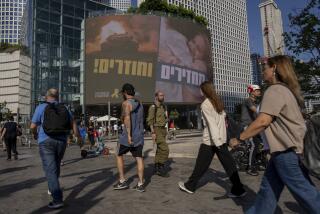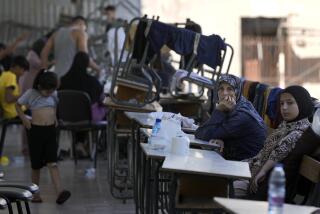Palestinian Towns Wobbling on Last Legs
DEIR ISTIYA, West Bank — Fuad Awad rolls his own cigarettes these days to save the $3 that his two-pack-a-day habit demanded. With the extra money, he buys a little chicken for his children.
The house that Saeed Zeidan was building for his family sits half-finished, concrete blocks bare to the wet wind. No job, no money.
Nazmi abu Ali burns tree bark in a tin can to heat the rooms where his two toddlers sit most of the day, passing the time.
Across the West Bank, villages and towns like this one are dying a slow death. More than two years of closures, curfews and the pressure of Israeli army tanks have ruined the livelihood, the economy, the agriculture, the education and in some cases the health of hundreds of thousands of Palestinian men, women and children.
The land that not so long ago seemed poised to take off as the new Palestinian state is today etched in rubble and poverty. In a shift of momentous proportions, Israeli Prime Minister Ariel Sharon has succeeded in collapsing the Palestinian Authority and relegating its head, Yasser Arafat, to political oblivion.
Israelis say the Palestinians are to blame for their fate. The army reoccupied the West Bank and parts of the Gaza Strip as part of a campaign to stop suicide bombers and root out Palestinian gunmen fighting Israeli forces and killing Israeli civilians.
Palestinians say their entire population is being made to suffer for the actions of a few.
There is plenty of blame to go around. One thing is certain: Palestinians are facing a long-term deterioration of the society they hoped to build, and their vision of independence and sovereignty has rarely seemed more remote. By the same token, Israel in the coming year will have to decide whether to assume the job of providing basic services to the reoccupied territory or risk being blamed for a major humanitarian disaster at its doorstep.
Elsewhere in the West Bank -- in Ramallah, say, or Nablus -- physical damage may be more dramatic, the death toll higher. But it is in the dozens of small towns here that would form the backbone of a future Palestine where the erosion is most insidious.
In Deir Istiya, hardly an adult male today has work. Barter has replaced commerce. The single clinic is overrun with patients but undersupplied with medicine. Children sometimes don’t have enough to eat, and signs of malnutrition have crept into a population that was once relatively healthy.
*
Essentially Trapped
The 4,000 or so residents of Deir Istiya are essentially trapped. The entrance to the town is blocked by three haphazard walls of rust-red boulders courtesy of the Israeli army. Residents periodically open up an alternative, muddy path through nearby olive groves to allow passage of a few hardy souls and four-wheel-drive vehicles. The army routinely detects and closes the paths, and the residents find new ones to open.
Doctors, some students, merchants and officials make the tedious journey from Deir Istiya to other towns for supplies, studies or business. Most residents, however, don’t leave, or do so only rarely.
Buildings in this ancient-stone town have the look of desertion. Even on a recent weekday afternoon, after the rain had stopped and yellow light streaked the sky, almost every store was shuttered. Restaurants and most businesses closed down long ago.
Three generations of Deir Istiya males loitered in the streets, as they do most days. The older men placed plastic chairs at roadside, facing nothing really except an empty street and a stand of cactus and silvery olive trees. They smoked narghiles and talked about politics and the number of Palestinians killed that day in gun battles with Israeli troops. Someone roasted freshly shucked ears of corn.
As Israeli helicopter gunships passed overhead, one man, 65-year-old Ali Mansour, railed against America. “They give us flour to feed us with one hand,” he said, referring to U.S. food donations, “and give Israel the weapons to kill us with the other hand.”
Unlike many other Palestinian towns, Deir Istiya -- 24 miles from Tel Aviv and surrounded by Jewish settlements -- is not plastered with posters of “martyrs,” Palestinians killed by Israeli forces in the ongoing conflict. Despite that, the town did produce a handful of such figures. Three gunmen who hailed from the village were killed in a clash with Israeli troops about a year ago; another native son was a suicide bomber in the Israeli city of Netanya almost two years ago.
The siege on Deir Istiya was tightened after two ambushes at the nearby settlement of Emmanuel, one in July that killed nine Israelis and another seven months earlier that killed 11.
During a recent visit to the village, Deir Istiya’s sparse, clean clinic was the center of most activity. Dr. Yasser Qasin, 29, said he sees an average of 80 patients on the two days a week he practices -- twice the number who sought care before the intifada. There is a high rate of hypertension, diabetes and gastrointestinal disease, which he chalks up to stress and poor nutrition. Of special concern, he said, is a slightly higher rate of miscarriages and heart attacks, lower birth weights and anemia in mothers and children.
Births are down, as well, he said. Eighty-seven babies were born in Deir Istiya last year; there were 57 this year, and almost all at home, not in hospitals. “If you want to take your wife to a hospital to deliver, it’s impossible now” because of army roadblocks, Qasin said.
Qasin has worked at the clinic for a year. He used to practice in the hospital in Jericho, but he can no longer reach that eastern city with any certainty.
Abir Selman, a nurse, has worked in Deir Istiya and neighboring villages for a decade.
“Nobody is born big anymore,” said Selman, 30. Babies are often anemic and stay that way the first couple of years of their lives, she said. Their faces are pale, their eyelids are pink instead of red, they are listless. “We had this before [the intifada], but it was much less,” she said.
Sundus Abdul-Karim, pregnant, anemic and suffering a kidney stone, shuffled into the clinic for her appointment. Dressed in a velour robe-like dress and plastic sandals, despite the cold, she said her husband hasn’t worked in months, and they can no longer take their deaf 7-year-old for special education in Ramallah.
This is her 12th pregnancy. The 36-year-old manages to feed her children bread, rice and tea with sugar from donations ferried in by the Red Cross once a month or so. Occasionally they obtain chicken. For the youngest, she makes a pudding-like substance from starch and water, “whatever I can do to make them think they have milk,” she said. “To fill their stomachs and stop them from crying.”
People like Abdul-Karim were always poor and are more so now. But many Palestinians had reached a level of prosperity in the years leading up to the September 2000 outbreak of the intifada. That makes the deterioration so startling.
A survey over the summer by the Johns Hopkins schools of medicine and public health, which was financed by the U.S. Agency for International Development, found that one in five children under age 5 in the Palestinian territories is suffering from malnutrition. The study said the figure was on a par with impoverished Third World countries such as Bangladesh. Before 2000, Palestinians had the highest standard of living and education of any Arab people outside the Persian Gulf region.
Palestinian society has flipped from being highly productive to being dependent on handouts and humanitarian aid.
“So rapid has been the humanitarian collapse that it will take an [enormous] emergency program ... to prevent a complete breakdown in Palestinian society,” the commissioner general of the United Nations’ Palestinian refugee agency, Peter Hansen, said this month in announcing a multimillion-dollar appeal for donations.
Israeli military officials say they make the delivery of food and medicine a priority in the villages and towns that they have sealed off. They deny impeding medical care or other help.
Israeli Physicians for Human Rights, after a survey in the West Bank, concluded that stillbirths were up fivefold in rural Palestinian areas and vaccination programs depleted. Palestinians give even bleaker statistics.
According to the World Bank, nearly three-quarters of Palestinians are living below the poverty line, defined as $2 a day, unemployment has soared to more than half the population and Palestinian industry is on the verge of collapse. The Palestinian economy loses $7.6 million a day, according to the U.N.
*
Widespread Pain
“Every place in the West Bank is really hurting,” said Thomas Neu, director of American Near East Refugee Aid, a U.S.-funded organization. “The physical devastation, from tanks and shelling, is just the tip of the iceberg. That’s cosmetic compared to other aspects” such as economic and agricultural losses, he said.
Numerous villages that live on what they grow simply decided not to plant this season, he said. Unable to reach a market for their products, and in some cases unable to reach the fields themselves, residents decided it wasn’t worth it.
In Deir Istiya, 70% of the work force had jobs in Israel before the intifada began, according to Mayor Nafez Mansour, one of the town’s two dentists, who says that only half his patients these days can afford to pay for treatment. Israel now bans most Palestinian workers, so most of Deir Istiya’s men are unemployed.
The rest depended heavily on olive harvesting. These Samarian hills are one of the West Bank’s richest olive-growing regions. The people of Deir Istiya and several neighboring villages had trouble harvesting this season because of attacks from Jewish settlers who claimed the groves were often used by terrorists as firing positions.
With the protection of foreign and Israeli peace activists, the Palestinians were able to finish the harvest successfully. Deir Istiya’s estimated half a million olive trees were plucked of their fruit, and gallons and gallons of oil were squeezed in antique, sputtering presses.
But then another problem emerged: Locked inside their village, the people of Deir Istiya could not reach their traditional markets to sell the oil.
Townsfolk like Fuad Awad, the man rolling his cigarettes, and Saeed Zeidan, the man whose house is unfinished, are now stuck with jugs of oil that they cannot sell, even after slashing the price 40%. Some villagers have taken to paying their bills or purchasing goods from the grocery store with olive oil.
Awad and Zeidan were born in Deir Istiya but, like many Palestinians, went to Kuwait to earn money before returning about 12 years ago. Things were comfortable in Deir Istiya. Even at times of political upheaval, it always seemed that there was work and a measure of prosperity.
But all that has changed, Zeidan said.
“People had money, there was work, either here or inside Israel,” said Zeidan, 46 and burly, wrapped in a black and white checkered kaffiyeh and torn leather jacket. “Now people are afraid. They don’t go out at night. They’re afraid of getting shot. The army comes and breaks into houses.”
Zeidan began building his family home just before the intifada started. He invested about $20,000 in what was going to be a two-story abode near the town’s entrance. But he lost his job in Israel as a construction subcontractor, and his project halted. He and his wife, Suheila, are living with their children and his parents, crowded into his late grandfather’s home.
In a society where large families are the norm, Zeidan says he and his wife are stopping at four.
“If you can’t take care of them,” Zeidan said, “why have children?”
More to Read
Sign up for Essential California
The most important California stories and recommendations in your inbox every morning.
You may occasionally receive promotional content from the Los Angeles Times.











